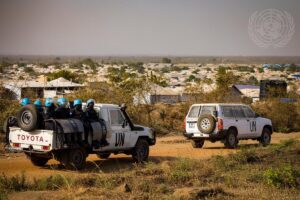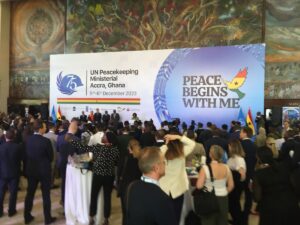The air domain is an integral part of UN peacekeeping. Air assets — such as fixed-wing aircraft, attack and utility helicopters, and uncrewed aerial systems (UAS) — enable peacekeepers to move personnel and materiel, obtain situational awareness and peacekeeping intelligence, and deter and respond to attacks. Characteristics such as speed, elevation, agility, and reach make air assets critical enablers in peacekeeping missions. Air power has a fundamental role in supporting the safety and security of peacekeepers and positioning them to accomplish their mission mandates.
Failures in mission settings to effectively utilize the air domain due to host-state restrictions have had deadly consequences for peacekeepers. Air assets and the use of the air domain are critical to mandate implementation by protecting civilians (e.g., in current contexts such as the Central African Republic (CAR) and South Sudan); supporting efforts to observe, monitor, and report on cease-fires or buffer zones (e.g., in Cyprus and Western Sahara) and arms embargoes (e.g., in Lebanon); enabling peacekeepers to undertake peacebuilding tasks and extend state authority through support to the security sector (e.g., in the Democratic Republic of the Congo (DRC)), and providing logistical support to regional peace operations or parallel operations (e.g., Somalia).
Despite the criticality of the air domain to peacekeeping operations, the UN has struggled to generate, sustain, use, and operate a range of air assets and capabilities across missions. Strategic and operational obstacles have included denial of freedom of movement by host authorities, complex command-and-control (C2) processes, restrictions and caveats applied by troop-contributing countries, pressures to drive down costs and increase efficiencies, limited expertise and diversity to support situational awareness and new technology platforms, and a lack of a gender-responsive approach to the air domain. Many of these problems are linked to issues pertaining to force generation, both in terms of military air assets and civilian contractors. Such obstacles are not necessarily limited to the air domain and are applicable across a range of member state-generated capabilities. The UN has historically relied upon a handful of air-contributing countries and commercial providers, but the war in Ukraine has highlighted the risks of this approach. Shortcomings pertaining to safety and security have contributed to a lack of political will among member states — particularly those with high-end capabilities — to commit personnel or air assets to peacekeeping missions.
In addition to supporting a military objective, air power in a peacekeeping context is also primarily deployed in support of a political objective. Unlike the use of air power in support of national objectives — where the political realm of decision is often far removed both geographically and organizationally from the tactical activities of military forces — air power in a peacekeeping sense is more closely entwined with the politics of UN intervention. It relies on extensive civil-military coordination, where civilians tend to lead on the management of logistics, while host-country authorities provide access to, or in some instances, obstruct, the air space. These considerations, where relevant, manifest themselves in vastly different ways than they do in conventional national military operations.
The notion of air power and the use of the air domain in the context of UN peacekeeping missions is quite distinct from its use in other contexts. Therefore it requires greater clarity and understanding among peacekeeping stakeholders to understand the roles, strengths, and limitations of air power in implementing peacekeeping mandates and achieving mission effectiveness. To support a more comprehensive approach to air power — one that links roles to the delivery of mission mandates — the UN Secretariat should work with member states to bring more clarity and coherence to the use of air power in the context of UN peacekeeping. This paper proposes an air power concept for UN peace operations that is guided by three core roles: providing mobility, enabling situational awareness, and mobilizing a response to attacks. Combined, these roles support military and civilian components within the mission and provide a deterrent effect, allowing peacekeepers to more effectively achieve their mandates.
The conceptualization of air power in UN peacekeeping missions differs significantly from the doctrinal approach in many national militaries due to a range of limitations. To start with, use of the term air power prompts concerns about the use of excessive force beyond the principles of peacekeeping, given the connotation of air strikes. This paper recognizes that peacekeeping missions must operate in compliance with the principles of peacekeeping, which notably differs from the traditional air power strategy and debates that occur at national command and staff colleges. Another key difference in the context of UN peacekeeping is the mandate and budget set by the Security Council and Fifth Committee respectively. Thus there is a disconnect between ways and means to achieve an end state or support the objectives of the mission. Decisions regarding which forms of air assets might be deployed are based on templated approaches (like other approaches to force generation), with limited consideration given to the effects that are being sought or the threat environment in which the assets might operate. The UN relies upon member states and civilian contractors to provide platforms, capabilities, and expertise; it does not have an independent capability to plan for and generate these capabilities for the organization. This situation tends to stifle innovation and the use of new technologies, which are imperative to adapt to the evolving threat environment in the air domain, as well as threats to the domain from other actors.
The threat environment in the air domain is rapidly evolving, presenting additional challenges to peacekeeping missions. The war in Ukraine has demonstrated the susceptibility of aircraft and air bases to attacks by cheap commercial drones that have been weaponized. Air power is no longer the exclusive domain of advanced militaries. Peacekeeping missions have already witnessed the use of UAS by non-state armed actors and spoilers to surveil mission operating bases, prompting questions about the need for counter-UAS measures and new doctrinal approaches in missions to prepare for and respond to these threats. This requires adaptation to employ the cyber and space domains more effectively as tools to gather situational awareness, safeguard communications systems, and protect aircraft and personnel from attacks. Peacekeeping must also keep pace with the adaptations taking place in other conflict settings within the air domain. For example, mission leaders need to reconsider how they plan for air infrastructure and the use of air bases, as well as the use of satellites and the electromagnetic spectrum in their operations.
Peacekeeping missions also continue to operate in an environment characterized by geopolitical tensions with difficult relationships with host authorities in some mission contexts, as well divisions in the Security Council over the strategic direction of peacekeeping. The authorization of the Multinational Security Support mission to Haiti in October 2023, as well as the recent deployment of subregional forces led by the East African Community and Southern African Development Community in eastern DRC has highlighted the need for greater clarity in terms of coordination, command and control, and de-confliction in the air domain. The adoption of Security Council resolution 2719 on the application of UN-assessed funding to African Union-led peace support operations is prompting further consideration of different models of peace support operations and partnerships. These developments have implications for the role of air power and should prompt debate about the role and comparative strengths required to enable UN peacekeeping missions to fulfill their mandates, as well as tools and reforms required within the UN Secretariat to modernize and implement an air power concept. Greater clarity will also enable a more holistic approach to air power as part of UN peace operations and support the maintenance of peace and security in an increasingly complex global security environment.
To address some of these challenges and seize opportunities to support future UN peacekeeping operations, this paper recommends that the UN Secretariat work with member states to:
- Articulate and communicate how air power supports mission effectiveness and mandate implementation through the development of a concept of air power for peacekeeping; systematically capturing data on when and how air assets contribute to the implementation of mission mandates; developing guidance on the integration of gender-responsiveness in the air domain; and incorporating concepts of air power into relevant pre-deployment and in-mission training programs.
- Ensure mission planning, procurement, and force generation processes are focused on the delivery of strategic effects in the air domain by developing a force generation framework that identifies the expected effect that will be required from a potential air contribution; diversifying contributions and supply chains for air assets; establishing a coordination mechanism or focal point for air capabilities across the UN secretariat; adopting an integrated systems approach to the use of air assets; ensuring aviation procurement mechanisms in the UN system are cost efficient and regularly reviewed; and capturing gender-disaggregated data on personnel serving in aviation units.
- Identify capabilities to counter the future threat environment to and from the air domain by developing a policy on UAS in peacekeeping missions; developing a defensive counter-air policy; and convening discussions with air-contributing countries and civilian contractors, among others, to consider lessons from other conflict settings and the application of emerging technologies to enhance force protection and mandates needs in peacekeeping missions.
- Better prepare for the role of air power in different future models of peace operations operating alongside multinational, regional, or sub-regional missions by considering the role of regional support models and inter-mission cooperation to deliver greater strategic effect; and to convene further discussions on the role of air power in different peace support operation settings.




